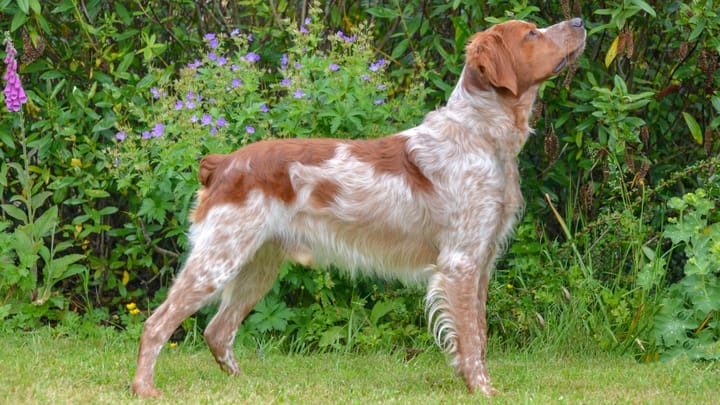Brittany
Other name: Brittany Spaniel


The Brittany Spaniel, a French hunting dog, has become wide-spread across the world thanks to his hunting skills and his qualities as a companion dog. Intelligent, docile, dynamic, and sociable, he adapts to all lifestyles. He can just as happily accompany his master to hunt all day as long as he stays at home with his loved ones. However, since he is very dynamic, he needs a very intense daily routine
|
Life expectancy |
The Brittany has a life expectancy of between 12 and 14 years |
|
Temperament |
|
|
Size |
Medium
|
|
Adult size |
Female
Between 18 and 20 in
Male
Between 19 and 20 in
|
|
Adult weight |
Female
Between 29 and 40 lb
Male
Between 29 and 40 lb
|
|
Coat colour
Several varieties exist: the coat can be white and orange, white and brown, or white and black. It is very rare, but good fortune, to meet a tricolour Spaniel or a roan coat (white hairs mixed with the dog’s main colour). Unicoloured subjects are not allowed by the official standard. |
Black White Brown Sand |
|
Type of coat
The hair is mid-length. His hair is very thin, flattened or slightly wavy. It is not silky, and it should not be curled either. |
Short |
|
Eye colour
The eyes’ colour is dark amber. |
Brown
|
|
Purchase price |
The Brittany costs between £580 and £940 |
He is particularly liked and widespread in France where you can find very good puppies. We must be careful, however, because some breeders, more focused on the results of their work, do not pay enough attention to the looks of the subjects. This is a mistake that could end up "splitting" the breed in two.
Also to note: this dog can sometimes be born without a tail (Anuran) or with a very short tail (brachyuran).
More details about the Brittany
Brittany: Origins and history
He originates from France, and more precisely from the centre of the Armorican Peninsula, as his name implies. Numerical statistics show that this dog is the most popular French hunting dog in the world. A first official standard of the breed was presented in France in 1907 and adopted in 1908. But it could be said that this breed is much older than that since this Breton may be the oldest of the Spaniel type dogs. One of his ancestors is likely to be the “Chien d' Oysel” and other breeds of setters or Springers have ended up improving this race in a fortuitous or voluntary way.
Physical characteristics of the Brittany
The Brittany Spaniel is a stocky dog; he is small and elegant although vigorous. His movements are energetic, his appearance is intelligent and his silhouette is square. His head is of medium size, the skull is of medium length, and the muzzle is ⅔ shorter than the skull. The stop is quite accentuated, gently sloping; straight or very slightly convex. The ears are located high, hanging, rather short, slightly rounded and a little fringed. His back is short. The tail is usually quite short and ends with a clump of hair. His limbs are rather feathered.
FCI classification of the Brittany
-
Group 7 - Pointing Dogs
-
Section 1 : Continental Pointing Dogs
Brittany: Characteristics
Brittany: Behaviour
Training a Brittany
Particularly docile, intelligent, and receptive, this Breton hunter is very easy to educate especially thanks to his enthusiasm to work.
Like many dogs selected for working tasks, he is thirsty to learn and spend time with his master in order to be mentally stimulated.
He may be stubborn sometimes; therefore, it is necessary to find methods adapted to his sensitivity and personality. Brutality cannot play any part in his educational sessions - instead they will have to be based on the reinforcement of good deeds.
With that said, his positive education requires firmness and sweetness as allies. It is important to begin as soon as the Brittany Spaniel puppy arrives at home to prevent him from learning bad habits.
Brittany: Lifestyle
Breed compatibility Brittany
Brittany: Purchase price
The price of a Brittany Spaniel varies depending on his origin, age and gender. An average of £940 are asked for a dog registered with the Kennel Club.
With regards to the monthly budget, between £35 and £45 will be necessary to support the physiological needs of this hunting dog.
Brittany: Shedding
Light
His hair loss is moderate but accentuated during the annual moult periods in the autumn and spring.
Brittany: Grooming
The maintenance of this hunting dog is not complicated. He does not need to be groomed, even if it is very dirty, because he tends to self-clean. Simple regular brushing will help maintain the quality and beauty of the coat.
However, it is necessary to monitor his ears which are easily irritated in the presence of foreign bodies, especially after a long walk in the forest or a hunting session.
Brittany: Health
His life expectancy is estimated at 13 years.
This is a very sturdy dog that has no major health problems. His lifespan also testifies to his great resistance.
Watch out for heatstroke, especially if this dog is working or practicing a regular sport. It is better to avoid intense activities during hot periods!
Given the fact that he is always eager to please his master and spend energy, this dog could easily push himself to exhaustion without noticing.
His double coat and great resistance allow this Breton dog to be very well protected against the bad weather. He can live outside without problems, but he still prefers the comfort of a basket in the house.
The great energy of this dog allows him to always keep trim. However, it is still necessary to offer him enough physical exercise to meet his needs. He cannot be overfed because, like any self-respecting dog, he will never say no.
- Coxo-femoral dysplasia
- Median patella dislocation
- Cystinuria






